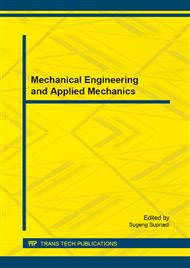p.21
p.29
p.35
p.45
p.51
p.57
p.63
p.71
p.77
Analysis of Micropattern Fabrication for Micromold Using Low Power CO2 Laser
Abstract:
The development of innovative micro components depends on the manufacturing system and process that reliable to produce the component in micro scale with good quality. In this case, using CO2 Laser is one of microfabrication techniques to fabricate material to get micro component. In this research, experiment was performed to fabricate micropattern using engraving method by Laser CO2 machine with several independent variables such as focus distance of nozzle Laser to workpiece (F), power of Laser (P), and velocity of nozzle Laser movement (V). The workpiece in this research was acrylic. Result of fabrication process will be identified and measured using digital microscope and surface roughness tester to get the value of workpiece quality such as surface roughness and geometrical properties as the dependent variables. The relationship of both variables will be expressed in 3D curves characteristic and mathematical models were analyzed by response surface methodology (RSM). The result of the analysis shows that the power of Laser (P) and velocity of Laser nozzle movement (V) effect is the significant variables affecting the quality of micropattern and micromold fabrications. Micromold can be fabricated using Laser CO2 with roughness value (Rax) is 17,55μm, width of grove (W) is 135 μm, depth (D) is 341 μm.
Info:
Periodical:
Pages:
51-56
Citation:
Online since:
April 2015
Authors:
Price:
Сopyright:
© 2015 Trans Tech Publications Ltd. All Rights Reserved
Share:
Citation:


